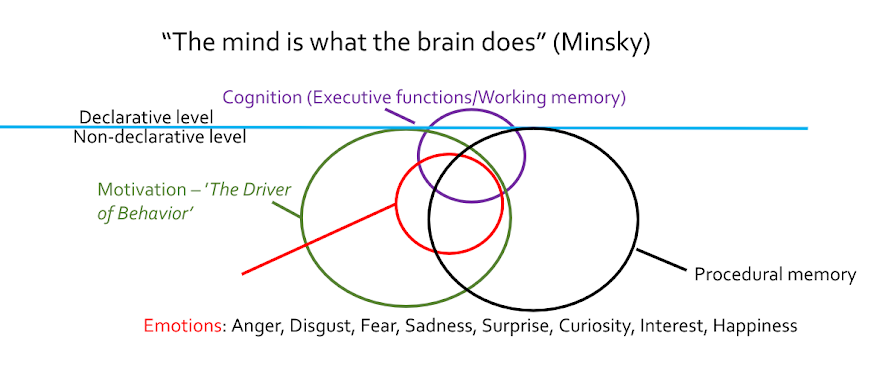Please support the blog via Swish (Sweden), MobilePay (Finland) or Wise.
In Finland, politicians are calling for entrepreneurial thinking. It raises the question: what is Entrepreneurial thinking?
Biological anthropology and neuro-psychological research together demonstrate that entrepreneurial thinking defines our species. That means that its not something some people have, but that we evolved into that kind of thinking, and that inhibitors in our environment are the only reason people in general are not using these higher order mental qualities.
Entrepreneurial thinking is based on our species' general ability to experience the future (Atance and O'Neill, 2001, 2005; Gilbert and Wilson, 2007), manifested by the action of milking other people of information (Pagel, 2019), or by combining non-related real or mental objects into new distinct categories (Einstein (see Hadamard, 1996); Wynn, Coolidge and Bright, 2009; Österberg, 2012, Österberg Köping Olsson, 2018, 2021).
The latter was demonstrated by the findings of the Lion-man, which shows that members of our species had the mental ability to combine non-related objects 40 000 years ago.
 |
| Photo: Chris Osburn Link to source. |
I have developed models which influence or facilitate entrepreneurial thinking.
1. Generative learning management - a two-factor model for leadership that affects work climate and social creativity within organizations (Österberg, 2004, 2012).
A statistical test confirms the proposition that leaders should emphasize two things: goal-assignment and decentralization of decision making to attain the goal to the level of operations.
2. Rational entrepreneurial thinking (Österberg, 2021) - a three-dimensional model that affects rational prospective thinking.
Adding to these models is work climate (similar to job satisfaction; Locke, 1976; James and James, 1989) - an intervening variable which has a ten dimensional latent structure: Clarity, Harmony, and Justice, Challenge, Independence, and Responsibility, Work facilitation, Support, and Recognition warm and friendly social relations (Ekvall, 1996).
A leader who applies these models will see an impact on organizational performance, learning, and social creativity for problem solving.
 |
| (Copyright) Peter Österberg (2024). |
Usually these kinds of processes are referred to as problem solving. But a Problem is not situational but a difference, between a current state and a goal-state. That implies that if you don't have a target (goal), you don't have a problem. Before trying to figure out a suitable target, it makes sense to start with the current state.
When the current state is defined, then the rather extensive work starts to figure out and formulate the target. That target is then communicated to the organization. Again, the difference between the current state and the goal-state constitutes the problem, or the problem space (Duncker, 1945). For example, if you are obese, have high blood pressure, or mental issues, the targets are: waistline: length minus 100, stable blood pressure, and the ability to activate your goal-oriented prospective thinking.
According to public records, the current state for Finland is the following:
- The national debt is 74% of GDP
In 2022.
- Finland has not been profitable for the past 15 years (HBL; 2022); business activities are not extensive enough for the tax revenue to cover national expenditure.
- Companies are registered, but the companies are not continued.
- The Ministry of Education and culture have reported that Finnish children have difficulties with reading comprehension and numeracy (May, 2022). Because the foundation for learning is laid in the home during the first five years of life, there are rumors that there are question marks about how adults think and behave (Helsingfors Police Department, Finland's child commissary; Children's right Conference, 2023).
- Research at the University of Helsingofrs has collapsed (Helsingin Sanomat, 2023).
 |
| The research collapse at the University of Helsingfors, according to Helsingin Sanomat (Dark blue Line; 2023). |
If the current state is accepted, then the work starts to formulate a common goal which is then communicated to people in various organizations. Note. Even though the models to form prospective thinking are general, the target will vary with the organization's business.
- I have successfully helped individuals and organisations to formulate goals to facilitate performance, and entrepreneurial thinking.
- I am in Finland because I am an expert beyond the ordinary.
- I now offer courses, lectures and executive coaching.
Also visit: An introduction to Peter Österberg, Ph.D.
Please support the blog via Swish (Sweden), MobilePay (Finland) och Wise.
More about my expertise:
Executive coaching for CEOs/managers and workshops to facilitate Organizational Performance, Learning, and Creativity for Problem Solving | Lectures: Nutrition for physical and mental health | Course/lecture: children's emotional and social adjustment and cognitive development | Language training - Swedish | Academy Competency | CV | Teaching skills and experience | Summary of research project | Instagram | Linkedin | YouTube-channel | TikTok | Twitter


No comments:
Post a Comment